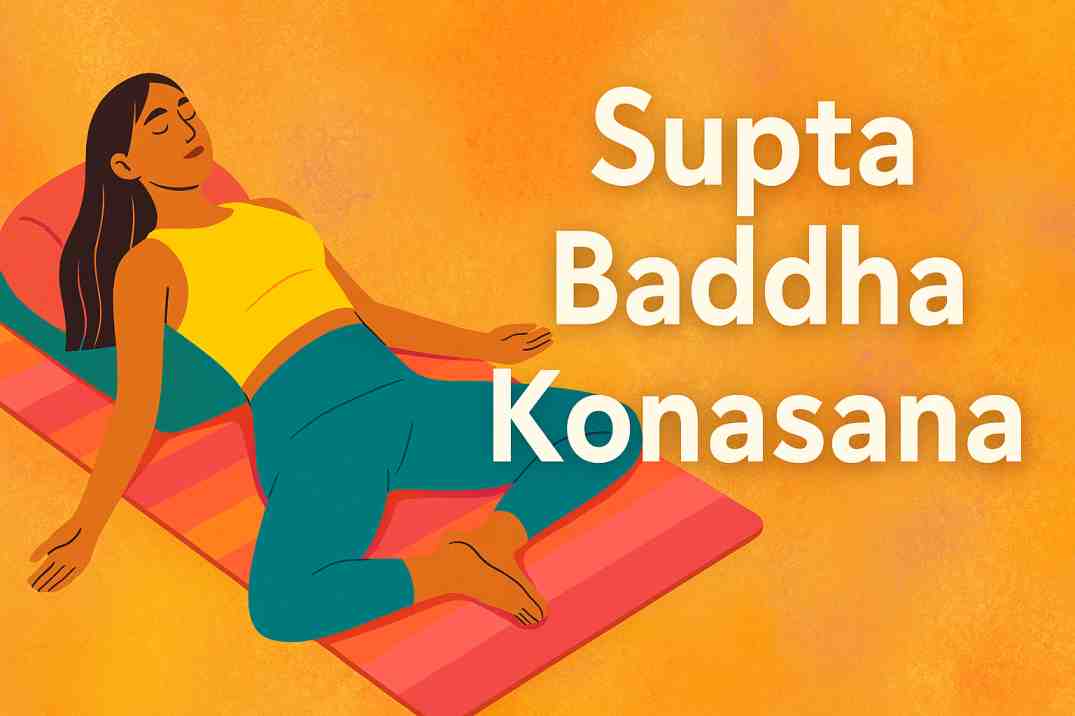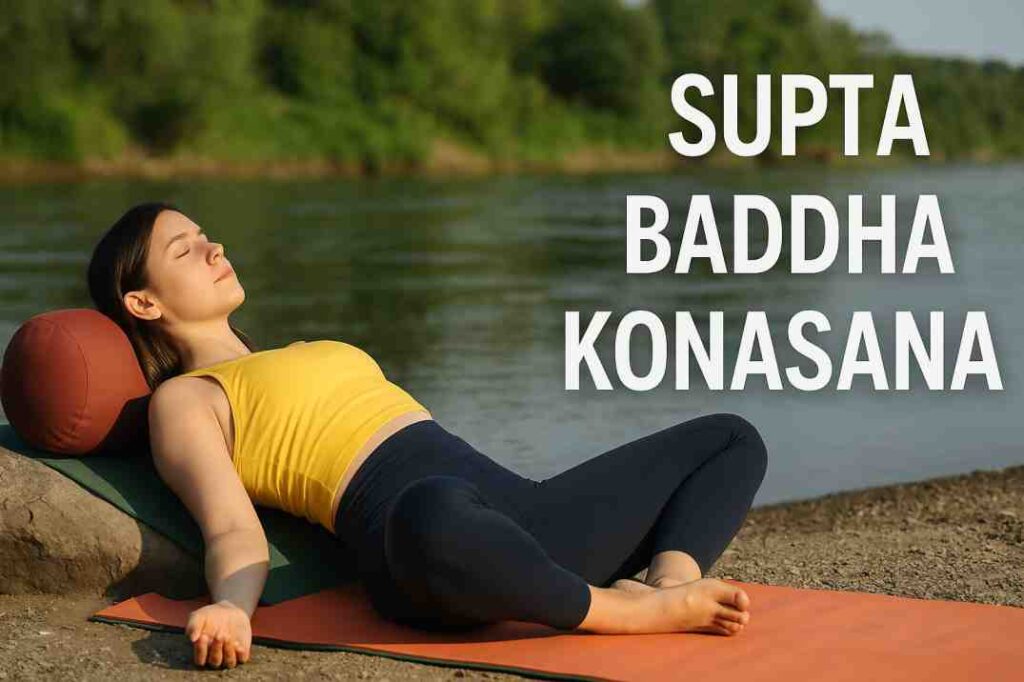What Is Supta Baddha Konasana?
Supta Baddha Konasana is a soothing yoga pose that makes you relax, open your hips and soothe your mind. It is also referred to as the Reclining Bound Angle Pose or Reclined Butterfly. The name is derived from Sanskrit: “Supta” refers to lying down “Baddha” refers to bound, “Kona” refers to angle and “Asana” refers to pose. This pose is performed lying on your back with the soles of your feet touching and your knees splaying out to the sides. It is one of the best rest, recovery and quiet time poses. You don’t have to be flexible or strong to do it just willing to slow down and breathe.
Table of Contents
How to Do the Pose
- Begin by sitting on a yoga mat or a soft surface. Bring your soles of your feet together and allow your knees to fall out to the sides.
- Your legs will form a diamond shape. Then lie back slowly. If it is uncomfortable to lie flat, you may use a bolster, cushion or rolled-up blanket under your head and back.
- Rest your arms at your sides, palms up.
- You can also put your hands on your belly or chest to sense your breath.
- Shut your eyes and relax your face. Try not to move and let gravity open your body.
As you recline in Supta Baddha Konasana, you might sense a gentle pull in your inner thighs, hips and lower belly. You may notice your chest relaxing and your breath becoming slower. Initially, if your hips are also tight, it will feel like your legs are being pulled or floating, but you can improve with pillows placed under the knees. With time, as the muscles relax, you will be supported and rooted. Most people describe this pose as making them feel secure, cozy and tranquil.
How Long Should You Remain in It?
You can remain in Supta Baddha Konasana for only a couple of minutes or even 20 minutes. When using it in a yoga class 2 to 5 minutes may suffice. When using it for relaxation or emotional healing, you can remain longer. Some individuals even sleep in this asana. Simply ensure that you are supported and have warmth. Use a blanket over your body if you’re lying down for more than 5 minutes, especially in a cool room. Your breath should stay smooth and easy the whole time.
Breathing in the Pose
Breathing is important in this pose. Start by noticing your natural breath. Then try to slow it down. Inhale gently through your nose, feel your belly rise, and exhale slowly. You can count to four while inhaling and to four while exhaling. This is referred to as “equal breathing” and will calm down the nervous system. You do not have to try to do anything simply maintain a calm and steady breath. On every exhale, visualize your body becoming heavier and your mind releasing tension.
What Props Can You Use?
Props are your best friends when in this pose. You can utilize folded blankets, cushions, bolsters or yoga blocks. Place cushions beneath your knees so that your legs don’t feel as though they’re dangling. Place a long pillow or bolster along your spine to support lifting your chest slightly and opening your heart. You can also utilize a small blanket or pillow under your head for support. If your feet are sliding apart, place a yoga strap around your hips and feet to maintain their position. You want to feel completely supported and effortless.
Read More: Yoga Poses for Two People: 10 Easy Moves for Beginners
Physical Benefits
This pose is wonderful for the body in numerous ways. It stretches the hips, inner thighs, and groin without compromising your muscles. It brings the chest and shoulders open, particularly if you recline on a bolster. It maintains proper blood flow to the pelvis that can aid in digestion, reproductive well-being and ease of menstruation. It can alleviate tension in the back, particularly if you spend most of the day sitting. It also maintains the spine, particularly when lying on a cushion. Since you’re not pushing or pulling, your body gets to relax and heal.
Mental and Emotional Benefits
One of the prettiest aspects of Supta Baddha Konasana is the way it is soothing. When you rest in this pose and breathe slowly, your nervous system starts to calm down. It engages the parasympathetic nervous system, which is the side of your body that allows you to relax, digest, and heal. If you’re anxious, stressed, upset or tired, this pose can be like a big, cozy hug. It opens room for quiet, and that can bring clarity of mind and peace of heart. It’s also an excellent release for stuck feelings, particularly in the hips where we carry tension.
Who Should Be Cautious?
While this is a soft pose, there are certain individuals who need to be careful. If you experience knee pain or injuries, put pillows under the thighs to support the legs. If you experience lower back pain, lie on a cushion or maintain a raised back. During pregnancy, propping yourself up on a pillow is best so you don’t lie flat. Always pay attention to your body. If you start to feel tingling, pain, or sharpness, slowly exit the pose. You can always attempt another position or get assistance from a yoga teacher.
When Should You Practice It?

You can practice Supta Baddha Konasana any time. It’s ideal first thing in the morning to rouse yourself kindly. You can practice it at midday to rebalance your energy or as a calming treatment before bed. It’s ideal before sleep also if you cannot sleep. Practically everyone leaves it as part of a class yoga practice toward the end since it’s relaxing. Some individuals even take brief work breaks to recline in this position for a few minutes to calm themselves down. You don’t have to be using a yoga mat—your couch, bed or even carpeted floor can do.
How It Helps With Emotions
This position allows you to tap into your emotions in a peaceful, secure manner. Since it opens your chest and pelvis, places where we tend to store emotions, it can bring up feelings. Occasionally, folks will experience a release of sadness, joy, or just calmness. That’s healing and normal. Don’t try to force anything. Just breathe and let whatever arises. Regular practice of this pose can make you feel more grounded and connected to yourself.
Read More: How Long Does it Take to walk 10k steps
Chakras and Energy
In yoga, Supta Baddha Konasana is related to the lower chakras. These are energy centers within the body. It engages the root chakra (Muladhara), which is related to security and stability and the sacral chakra (Svadhisthana), which is about feelings and creativity. If you place yourself on a bolster and open the chest, it also relates to the heart chakra (Anahata), which is concerned with love and compassion. This position aids in allowing energy to flow throughout the body smoothly and harmoniously.
Attempt It With Meditation or Music
You can also incorporate meditation, soft music or guided breathing into this pose. Some individuals prefer to use soothing music or sounds from nature when reclining in Supta Baddha Konasana. Others utilize an eye pillow or dim the lights to access a deeper state of rest. If journaling or establishing intentions appeal to you, this pose is an excellent spot to do so. At the end of a difficult day, it can be your time of peace to tune into yourself.
How to Build a Daily Practice
You don’t have to have a lengthy routine to reap the rewards. Even 5–10 minutes in this pose each day can help lower stress and promote better sleep. Try it just before bed with a blanket draped over you. Or take a mid-day screen break and task pause and use it. If you’re just starting out with yoga, you can use just this pose for your entire practice. It is easy, but the results are dramatic.
What You May Observe Over Time
If you practice daily, you will find yourself more flexible in your hips and thighs. You may find that you sleep better or are less irritable during the day. On an emotional level, you might feel more comfortable or more open to your emotions. You might also become more sensitive to your breath and its impact on your mood. It’s not merely a stretch—it’s a reset button for your entire being.
Read More: What Products Does rox.com Offer? Focus on the Products Listed on their Website (rox.com).
A Pose for All Seasons of Life
Supta Baddha Konasana is a pose you can come back to at any stage or age in life. Regardless of whether you’re young or old, fit or recovering, this pose changes to suit you. It is invigorating when you are exhausted, nurturing when you’re blue and stabilizing when you’re tense. You don’t have to perform or “get it right” you merely have to relax back and be. That is what makes it so therapeutic.
Final Thoughts
Supta Baddha Konasana is a soothing yet potent yoga pose that cradles your body, mind and emotions. It assists in opening tight hips, calming your breath, soothing your nerves and allowing room for healing. You don’t require experience, strength, or flexibility to practice it—just a few minutes and a peaceful space. No matter if you’re fighting stress, seeking peace or just need a time-out, this pose is always an option. Incorporate it into your every day and eventually, you might find it’s more than a yoga pose—it’s a tiny act of self-love and self-care.
Resources
- Yoga Journal – https://www.yogajournal.com/poses/reclining-bound-angle-pose/
- YogaUOnline – https://yogauonline.com/pose-library/supta-baddhakonasana-reclining-bound-angle-pose-rest-and-digest/
- Tummee – https://www.tummee.com/yoga-poses/reclined-bound-angle-pose/steps
- Beyogi – https://beyogi.com/learn-yoga/poses/reclining-bound-angle-pose/
- FlexifyMe – https://www.flexifyme.com/blogs/supta-baddha-konasana/

At TruceCare.com, our team is dedicated to providing reliable and well researched health Content Information as blog. Our articles are always written by experienced health writers and reviewed by certified healthcare professionals to ensure accuracy and clarity. We focus on sharing valuable insights into nutrition, wellness and overall health to help readers make informed decisions. We updates our articles regularly whenever it needed.
